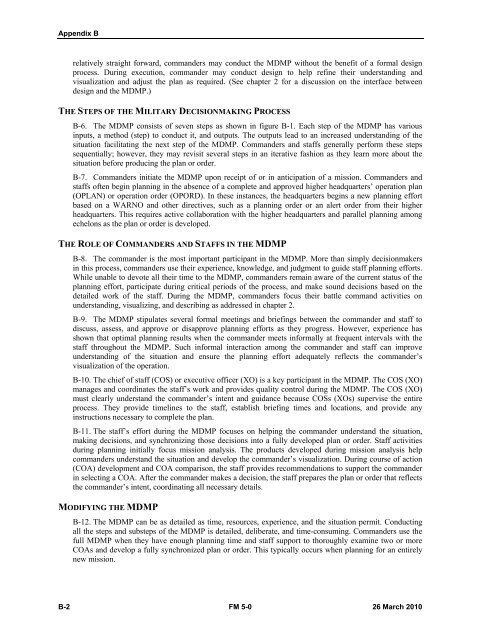FM 5-0, The Operations Process - Federation of American Scientists
FM 5-0, The Operations Process - Federation of American Scientists
FM 5-0, The Operations Process - Federation of American Scientists
You also want an ePaper? Increase the reach of your titles
YUMPU automatically turns print PDFs into web optimized ePapers that Google loves.
Appendix B<br />
relatively straight forward, commanders may conduct the MDMP without the benefit <strong>of</strong> a formal design<br />
process. During execution, commander may conduct design to help refine their understanding and<br />
visualization and adjust the plan as required. (See chapter 2 for a discussion on the interface between<br />
design and the MDMP.)<br />
THE STEPS OF THE MILITARY DECISIONMAKING PROCESS<br />
B-6. <strong>The</strong> MDMP consists <strong>of</strong> seven steps as shown in figure B-1. Each step <strong>of</strong> the MDMP has various<br />
inputs, a method (step) to conduct it, and outputs. <strong>The</strong> outputs lead to an increased understanding <strong>of</strong> the<br />
situation facilitating the next step <strong>of</strong> the MDMP. Commanders and staffs generally perform these steps<br />
sequentially; however, they may revisit several steps in an iterative fashion as they learn more about the<br />
situation before producing the plan or order.<br />
B-7. Commanders initiate the MDMP upon receipt <strong>of</strong> or in anticipation <strong>of</strong> a mission. Commanders and<br />
staffs <strong>of</strong>ten begin planning in the absence <strong>of</strong> a complete and approved higher headquarters’ operation plan<br />
(OPLAN) or operation order (OPORD). In these instances, the headquarters begins a new planning effort<br />
based on a WARNO and other directives, such as a planning order or an alert order from their higher<br />
headquarters. This requires active collaboration with the higher headquarters and parallel planning among<br />
echelons as the plan or order is developed.<br />
THE ROLE OF COMMANDERS AND STAFFS IN THE MDMP<br />
B-8. <strong>The</strong> commander is the most important participant in the MDMP. More than simply decisionmakers<br />
in this process, commanders use their experience, knowledge, and judgment to guide staff planning efforts.<br />
While unable to devote all their time to the MDMP, commanders remain aware <strong>of</strong> the current status <strong>of</strong> the<br />
planning effort, participate during critical periods <strong>of</strong> the process, and make sound decisions based on the<br />
detailed work <strong>of</strong> the staff. During the MDMP, commanders focus their battle command activities on<br />
understanding, visualizing, and describing as addressed in chapter 2.<br />
B-9. <strong>The</strong> MDMP stipulates several formal meetings and briefings between the commander and staff to<br />
discuss, assess, and approve or disapprove planning efforts as they progress. However, experience has<br />
shown that optimal planning results when the commander meets informally at frequent intervals with the<br />
staff throughout the MDMP. Such informal interaction among the commander and staff can improve<br />
understanding <strong>of</strong> the situation and ensure the planning effort adequately reflects the commander’s<br />
visualization <strong>of</strong> the operation.<br />
B-10. <strong>The</strong> chief <strong>of</strong> staff (COS) or executive <strong>of</strong>ficer (XO) is a key participant in the MDMP. <strong>The</strong> COS (XO)<br />
manages and coordinates the staff’s work and provides quality control during the MDMP. <strong>The</strong> COS (XO)<br />
must clearly understand the commander’s intent and guidance because COSs (XOs) supervise the entire<br />
process. <strong>The</strong>y provide timelines to the staff, establish briefing times and locations, and provide any<br />
instructions necessary to complete the plan.<br />
B-11. <strong>The</strong> staff’s effort during the MDMP focuses on helping the commander understand the situation,<br />
making decisions, and synchronizing those decisions into a fully developed plan or order. Staff activities<br />
during planning initially focus mission analysis. <strong>The</strong> products developed during mission analysis help<br />
commanders understand the situation and develop the commander’s visualization. During course <strong>of</strong> action<br />
(COA) development and COA comparison, the staff provides recommendations to support the commander<br />
in selecting a COA. After the commander makes a decision, the staff prepares the plan or order that reflects<br />
the commander’s intent, coordinating all necessary details.<br />
MODIFYING THE MDMP<br />
B-12. <strong>The</strong> MDMP can be as detailed as time, resources, experience, and the situation permit. Conducting<br />
all the steps and substeps <strong>of</strong> the MDMP is detailed, deliberate, and time-consuming. Commanders use the<br />
full MDMP when they have enough planning time and staff support to thoroughly examine two or more<br />
COAs and develop a fully synchronized plan or order. This typically occurs when planning for an entirely<br />
new mission.<br />
B-2 <strong>FM</strong> 5-0 26 March 2010















